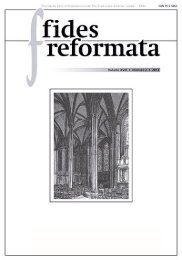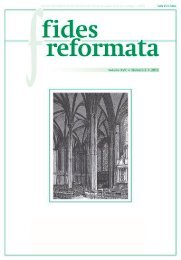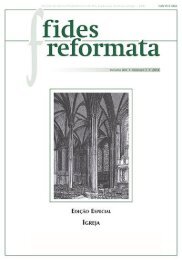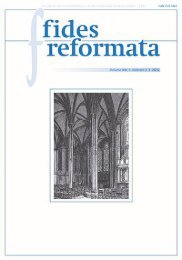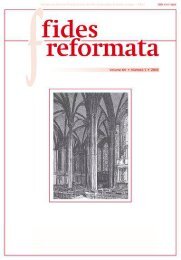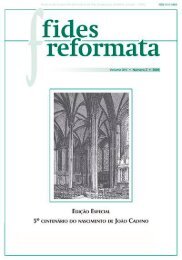Create successful ePaper yourself
Turn your PDF publications into a flip-book with our unique Google optimized e-Paper software.
P.H.R. (Rob) van Houwelingen, John and the Others<br />
may believe that Jesus is the Christ, the Son of God, and that by believing<br />
you may have life in his name.<br />
Here ταῦτα δὲ γέγραπται <strong>do</strong>es cover the whole book, because (a) the<br />
first of the σημεῖα is already recorded in chapter 2; (b) ἐν τῷ βιβλίῳ τούτῳ<br />
has to imply the book as a whole. We also find here an impersonal passive<br />
construction, because the author keeps concealing himself in the material he is<br />
presenting. However, he connects it to the confession of Thomas that Jesus<br />
is his Lord and his God. He has reached his goal with that, because the writer<br />
desires to lead his readers to the same profession of faith as Thomas. In 12:37<br />
the evangelist assessed their response yet with disappointment: “Though he<br />
had <strong>do</strong>ne so many signs before them, they did not believe in him.” The more<br />
blessed are those who have not seen and yet have believed.<br />
The first Epistle of John also has an objective, where the writer personally<br />
directs himself to his readers in the “I”-form:<br />
1 John 5:13<br />
Ταῦτα ἔγραψα ὑμῖν ἵνα εἰδῆτε ὅτι ζωὴν ἔχετε αἰώνιον, τοῖς πιστεύουσιν<br />
εἰς τὸ ὄνομα τοῦ υἱοῦ τοῦ θεοῦ.<br />
These things have I written to you that you may know that you have<br />
eternal life, you who believe in the name of the Son of God.<br />
This objective of 1 John 5:13 is not written at the end of the epistle 48 , but<br />
it is connected to the confession of God’s Son being the true life (verse 12).<br />
The writer (“I”) would like to lead his readers (“you”) to the same confession<br />
of faith.<br />
When we similarly reconstruct John 20:30-31 in the first person plural<br />
the purpose for recording the events is expressed as follows:<br />
Πολλὰ μὲν οὖν καὶ ἄλλα σημεῖα ἐποίησεν ὁ Ἰησοῦς ἐνώπιον ἡμῶν, ἃ οὐκ<br />
ἔστιν γεγραμμένα ἐν τῷ βιβλίῳ τούτῳ: ταῦτα δὲ γέγραφα ἵνα πιστεύ[σ]<br />
ητε ὅτι Ἰησοῦς ἐστιν ὁ Χριστὸς ὁ υἱὸς τοῦ θεοῦ, καὶ ἵνα πιστεύοντες ζωὴν<br />
ἔχητε ἐν τῷ ὀνόματι αὐτοῦ.<br />
Many other miraculous signs did Jesus in our presence, which are not<br />
written <strong>do</strong>wn in this book, but I have written these that you may believe<br />
48 For the sake of comparison Baum quotes four Old Testament epilogues from the Old Testament;<br />
three of them are not placed at the end (Ps. 72:20; Jer. 51:64; 1 Kings 11:41). The one of Numbers 36:13<br />
only functions as the end of the whole book. BAUM, Observations, p. 125: John <strong>do</strong>es not follow the<br />
Greek-Roman convention, but – if he had, in any event, a specific example in mind – the Old Testament<br />
or the early Jewish custom. See also 1 Mac.9:22.<br />
112






